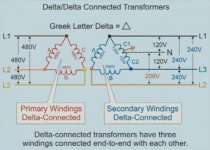I'm teaching myself about topics like this, so the following bears further confirmation by others:
Using the nomenclature in the diagram below, say you have an 80A secondary load connected L2 - N. Then if the impedance of coil A + coil C1 exactly matches the impedance of coil B and coil C2, the current would split with 40A flowing through A + C1 and 40A flowing through B + C2.
If the positive current direction is clockwise through A, C1/C2, and B, and away from the transformer for L1, L2, L3, and N, and if the 80A load is considered +80A on L2 and -80A on N, then the currents on the coils (A, B, C1, C2) are (-40, 40, -40, 40).
On the primary side, the currents are just half as much, and I believe the current in the C coil is just the transformation of the average current on C1 and C2 (not 100% sure on this, but what else could it be?) That would make the primary currents (A, B, C) to be (-20, 20, 0). Then the primary line currents are given by L1 = A - C, L3 = C - B, and L2 = B - A. That gives (L1, L2, L3) = (-20, 40, -20). The phase angle of those currents is in phase with the original secondary load current L2 - N.
Now contrast this with another way to get secondary currents of 40A in magnitude in each coil, namely just apply a 40A 2-wire load across each coil A, B, and C1/C2. That gives you 3 * 240 * 40A = 28.8 kVA of apparent power, while the 80A 208V L2-N load is just 16.6 kVA of apparent power, a factor of 1/sqrt(3) less.
Cheers, Wayne


